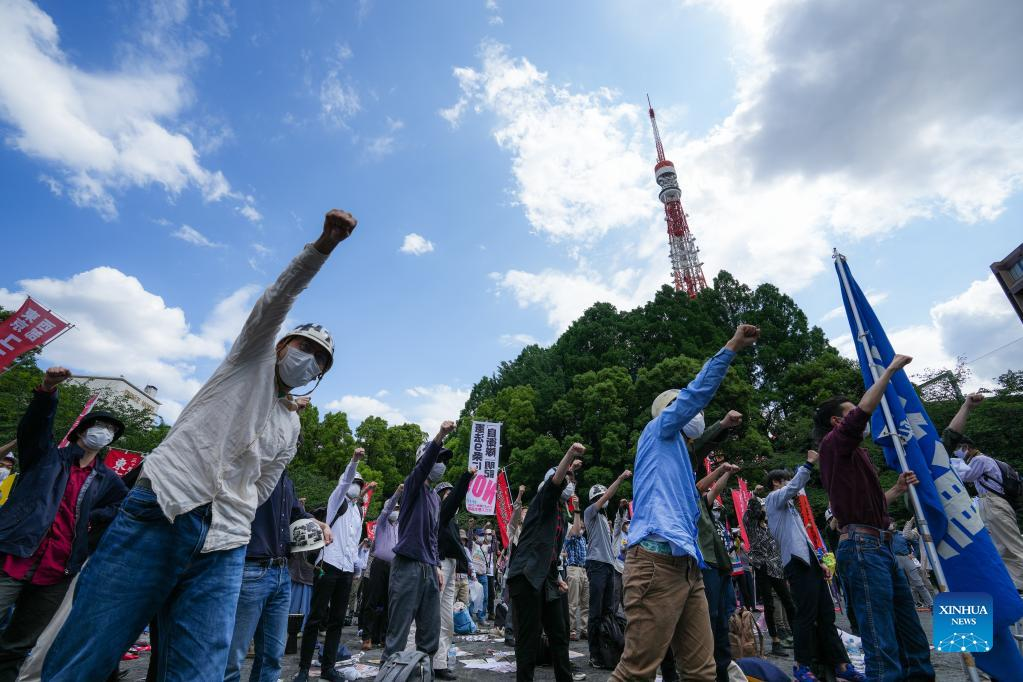2022年5月23日,华东师范大学外语学院国别与区域研究所副所长、亚洲和太平洋地区研究中心执行副主任陈晓晨接受人民日报英文客户端采访,谈美国主导的印太经济框架。
Beijing (People’s Daily) - US President Joe Biden unveils the Indo-Pacific Economic Framework (IPEF) on Monday when visiting Japan, as part of his first Asian trip since he took office. Experts told the People’s Daily that the economic initiative aims at building a regional economic order prioritizing US strategic interests and excluding China, which in essence serves politics and lacks viability.

Protesters gather at Shiba Park in Tokyo, Japan, May 22, 2022. US President Joe Biden arrived in Japan on Sunday, as about 750 protesters took to the streets here against the planned US-Japan summit and the summit of the Quadrilateral Security Dialogue (the Quad). (Photo: Xinhua)
The IPEF explicitly demonstrates the US strategy of building alliances, said Zhang Monan, chief researcher with the Institute of American and European Studies of the China Center for International Economic Exchanges.
With the US as the leader and US strategic interests as the core, and through the principle of exclusivity, the framework hopes to counter China’s growing influence in the Asia-Pacific and global economies, Zhang added.
The US wants to lead a regional economic framework in the Asia-Pacific, patch the hole represented by the absent economic agenda in its “Indo-Pacific strategy,” and build “de-sinicized” global supply chains, said Chen Xiaochen, deputy dean of the Institute of Area Studies at East China Normal University.
First introduced in October 2021, the framework was believed to make up for the lack of an economic pillar in the US “Indo-Pacific strategy” that has perceived security priorities. It was also viewed as a means to regain US economic clout after Donald Trump’s pull-out from the Trans-Pacific Partnership.
Chen said the IPEF could in form fill the missing economic leg in that strategy, but given its distinct purpose to serve politics and security and persuade regional economies to “decouple” from China, rather than level disparity and enhance ties, it is doomed to fail in the role of promoting global supply chains and free trade.
With the main goal to exclude China, the largest economy in the region, the IPEF does not bring long-term development benefits to ASEAN economies or others, and is not sustainable, noted Zhang.
If the US-led trade pact is open and inclusive to any country which indicates their willingness to join, it will help the region’s growth, said Zhuang Juzhong, former deputy chief economist of the Asian Development Bank.
“However, if it is a closed clique, or aims to exclude a certain country, it won’t necessarily be a blessing to the region and will distort the world’s resources allocation,” Zhuang added.
The Biden administration is attempting to restructure supply chains and industrial systems in Asia to favor America, but the economic initiative offers members few incentives such as greater market access or tariff cuts. It is not a traditional free trade agreement, US Trade Representative Katherine Tai has said.
Such characteristics indicate the IPEF is not an initiative for fair trade, Zhang pointed out. It inherently asks Asian countries to make compromises to fit US geographic ambitions.
“The IPEF will face an impossible triangle: it is hard to be simultaneously representative, exclusive and substantial,” Chen observed.
US trade partners in Asia already have a promising alternative for economic integration.
The Regional Comprehensive Economic Partnership (RCEP) entered into force on January, 1, 2022, which ensures the orderly and smooth flow of factors in the whole region through facilitating trade and investment and lowering market access barriers, said Zhang.
The RCEP covers 15 countries including ASEAN countries and US key allies in Asia.
The US government goes against reality and logic to kick China out of the region’s economic integration through the IPEF, Zhang said.
China, not America, is at the center of production and supply chains in Asia and its role in the economic dynamics of Asia and Pacific region is indispensable. Like it or not, China is the biggest economic presence in Asia, said Zhang.
ASEAN countries, which the Biden administration has courted to counter China’s influence, have cemented their active engagement with China over the past three years. In 2019, ASEAN replaced the EU to become China’s biggest trade partner in the world. In 2020, China-ASEAN trade hit $685 billion, double the size of US-ASEAN trade.
China should make use of current Asia-Pacific economic frameworks to further strengthen economic and trade exchanges with the region and take its economic integration with Asia-Pacific economies to the next level, said Zhang.